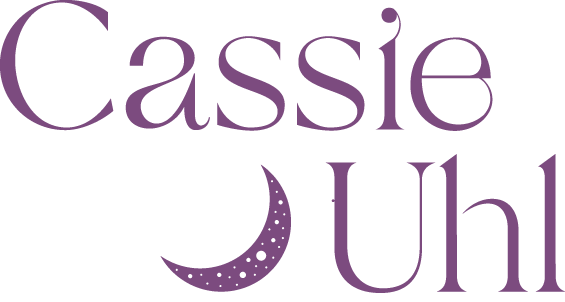How to Get Started with Spiritual Activism
If you’re reading this, you probably have a desire to make the world a better place. But you may feel like you’re not sure how to go about it in a way that aligns with your spiritual practice and values.Your spiritual practice and your activism aren’t separate, they’re one. They can be, and I think they should be— because the world needs you, as an activist, to show up as a spiritual being...and as a spiritual being, to show up as an activist.

If you’re reading this, you probably have a desire to make the world a better place. But you may feel like you’re not sure how to go about it in a way that aligns with your spiritual practice and values.
Your spiritual practice and your activism aren’t separate, they’re one. They can be, and I think they should be— because the world needs you, as an activist, to show up as a spiritual being...and as a spiritual being, to show up as an activist.

This means that not only are we meditating on healing the world, manifesting collective healing, and whatever other healing practices you have…but we’re also bringing that work into how we show up in the world as agents for change. We show up as our whole, spiritual selves when we call our senators and representatives. When we march, when we protest, when we volunteer, when we donate, when we organize, when we listen, when we post on social media.
That is spiritual activism.

COMPASSION
One really important piece of spiritual activism is compassion for yourself and for others. It’s really easy and often justified, to get caught up in your feelings and forget that the person you’re engaging with is also a human being. A human being who may be really offending you right now, but still a human being.
Remember that your feelings are justified. And of course, you don’t have to continue to engage with someone who is hurting you. But remembering some of the truths that are likely part of your spiritual practice, like compassion for all and the idea that at the core of it, we are all one, is just as important in these situations as it is in others.

ANGER
Ask yourself:
How do I want to feel?
How do I want others to feel around me?
List these answers out, and think about how they apply to your activism. If you want to feel inspired, open, safe, joyful, free, loved, whatever it is — you probably want other people to feel that way around you, too.
How can you approach your activism in a way that holds space for that? How can you approach your activism in a way that makes yourself and the people around you feel that way the majority of the time?
A note about anger: you probably want to create change around two things: things that break your heart, and things that make you angry. In some dialogue about spirituality, anger is bad. It’s something to be stifled and ignored.
But anger is human, and I think the only thing that makes it bad is repressing it. You’re going to be angry about injustice. It’s what we do with our anger, how we express it, and how we channel it that can help or hurt us.
So instead of repressing your anger or using it to lash out at people, I invite you to channel your anger into productive change, remembering that compassion and anger aren’t mutually exclusive.
START WITH YOU
When it comes to activism, start with you. It can be hard to wrap your head around at first but understand that you are not separate from the problem. You are not separate from these oppressive systems.

As a white person, racism isn’t about someone else. It’s about me.
As a cisgendered person, violence against transgender people isn’t about someone else, it’s about me.
The list goes on.
Ask yourself: in what systems am I an oppressor?
You can be oppressed in certain systems, like gender, and be the oppressor in others, like race.
This is where we get into the idea of privilege.None of this is about berating yourself for being a bad person or being complicit in these systems. You’re not a bad person! But the point of this being the first step is that when we know better, we do better. But we can’t do better if we don’t immerse ourselves in the “know better” step first.
Ask yourself: what privileges do I hold?
(Ideas: able-bodied privilege, white privilege, cisgendered privilege, straight privilege, thin privilege, in your country legally, etc.)
Take some time to really think about how those privileges manifest in your life and how they’ve become systems of belief. For example, what beliefs have you absorbed about people who don’t hold the privilege of being documented, or who don’t hold thin privilege?
What can you do to root down, shift those beliefs (which always manifest into actions even if you may not realize it!), and create more equality in your own life?
How is this spiritual activism? I think it comes back to the idea that healing yourself is healing for the world. I think most of us can probably get behind that. In this sense, cleaning up your own baggage, the ways in which your hurt and oppress is the most important thing we can do.
RELEASE
These days in this political climate I think it’s really important to have an embodiment practice to help you release trauma, anger, and other emotions you’re storing up from your cells. Tapping, breathwork, and a good old-fashioned scream are great ways to release.The practice can look like anything you need it to, but choose something that’s a physical release.
What Are the Doshas & How to Determine Yours
Ayurveda is known as the sister science to yoga. It’s a traditional Hindu system of medicine developed in ancient India, based on holistic integration of mind and body for optimal balance and health.The word literally translates to life science or knowledge, showing Ayurveda’s holistic approach to health. Unlike Western medicine, Ayurveda focuses on food and lifestyle, rather than medication, and prevention to help you get healthier before you get sick.
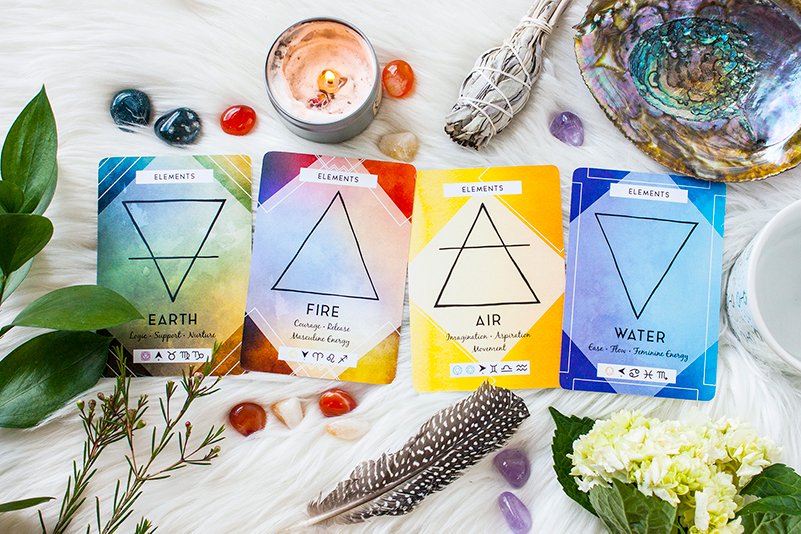
Ayurveda is known as the sister science to yoga. It’s a traditional Hindu system of medicine developed in ancient India, based on holistic integration of mind and body for optimal balance and health.
The word literally translates to life science or knowledge, showing Ayurveda’s holistic approach to health. Unlike Western medicine, Ayurveda focuses on food and lifestyle, rather than medication, and prevention to help you get healthier before you get sick.
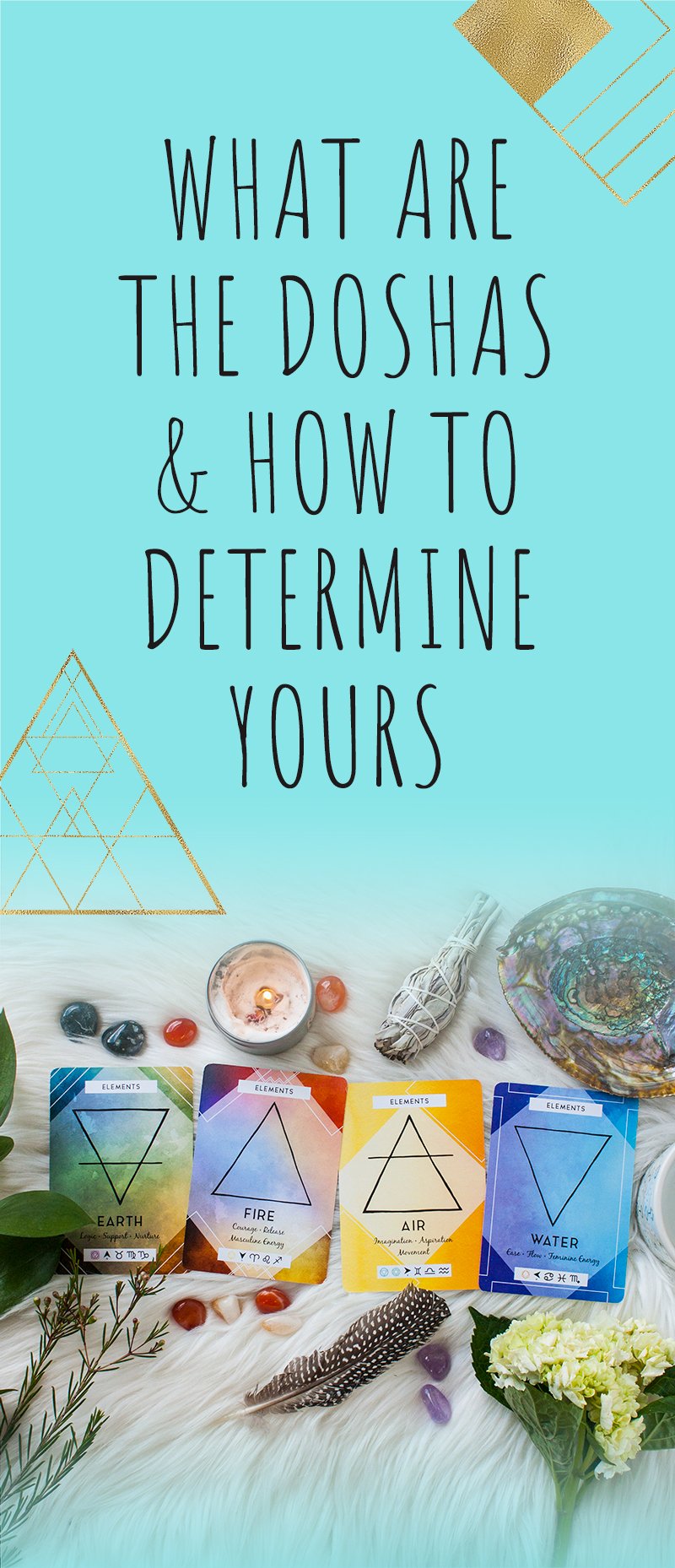
Ayurvedic Doshas
Doshas are the different types of energy in your body. Each dosha is associated with different elements and qualities, which I’ll get into below.
We’re each born with a specific dosha constitution, or makeup. We can learn a lot about what’s best for our bodies by understanding our our dominant dosha constitution.
There are three doshas: Vata, Pitta, and Kapha. Each of us has all three doshas within us, but we are typically dominant in one or two doshas. The qualities of each of these doshas manifest in your mental, physical, and emotional bodies (remember that holistic approach I talked about above!).
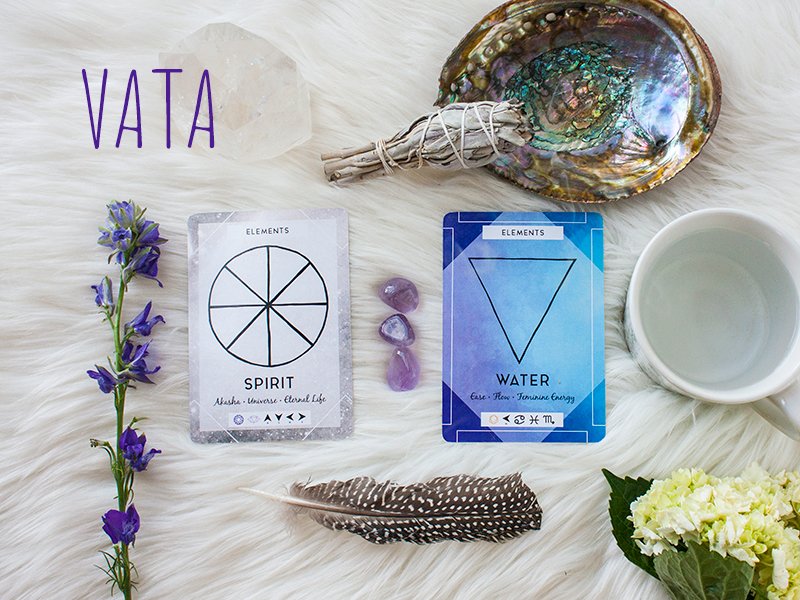
Vata is composed of space and air. Its qualities are dry, light, cool, rough, subtle, and mobile. You may be more Vata if you…
Tend to get stuck in your head or get more anxious energy
Have a lot of active, creative energy
Have dry or brittle skin and hair
Tend to run cold
Get constipated easily
Sometimes feel “spacey”
Have a thinner, lighter frame

Pitta is composed of fire and water. Its qualities are oily, sharp, hot, light, fleshy smelling, spreading, and liquid. You may be more Pitta if you…
Have active digestion
Usually run hot
Have oilier skin
Have to eat regularly and may get lightheaded or cranky if you miss a meal
Have a more fiery, aggressive personality
Get sweaty easily
Are a leader

Kapha is composed of water and earth. Its qualities are unctuous, cool, heavy, slow, smooth, soft, dense, viscous, and stable. You may be more Kapha if you…
Tend to need more sleep
Have a heavier frame
Have dense, thick hair
Move more slowly
Tend to get excess mucous
Are fairly laid-back
Are well-grounded
Are an empath or very sensitive person with a big heart
These are general guidelines. I recommend taking this quiz from Banyan Botanicals to find out for sure!
How to balance your Dosha
So you’ve discovered your dosha constitution. Now how do you balance it?Ayurveda uses the principle of like increases like, and therefore you can look to opposites as medicine.For those of us more dominant in Pitta energy, you can balance that Pitta by focusing on:
Sweet, bitter, and astringent tastes (think sweet potatoes and basil for sweet, turmeric and cumin for bitter, avocado and apples for astringent)
Cool and dry environments
Cultivating practices that help you go with the flow rather than force
Fresh, cooling foods
A cooling, relaxing yoga practice
For those of us more dominant in Vata energy, you can balance that Vata by focusing on:
Sweet, sour, and salty tastes (think dates and cashews for sweet, lemon and pickles for sour, and celery and sea salt for salty)
Calm, grounding environments
Stabilizing routines
Wetter, warmer climates
Warming, mushy foods like kitchery and soup
Doing one thing at one time (not multitasking)
Regular meditation
A warming yoga practice that cultivates fluidity and is easy on the joints
For those of us more dominant in Kapha energy, you can balance that Kapha by focusing on:
Pungent, bitter, and astringent tastes (think onion and garlic for pungent, turmeric and cumin for bitter, and avocado and apples for astringent)
A warm, dry climate
Warming, light foods (nothing too heavy)
An active routine including things like biking, running, and hiking
A more challenging, intense yoga practice in a warm environment
Learn more about the elements that make up the doshas from The Ritual Deck (pictured).
Resources for further study
As you can imagine, Ayurveda is a complex, in-depth system that you’re not going to learn in one blog post. If you’d like to go deeper, I recommend checking out some of these resources:
Ayurveda: The Science of Self Healing by Dr. Vasant Lad
The Complete Book of Ayurvedic Home Remedies: A Comprehensive Guide To The Ancient Healing of India by Dr. Vasant Lad
Ayurveda by Sahara Rose
The Everyday Ayurveda Cookbook by Kate O’Donnell
How to Open Your Sacral Chakra & Know When it's Blocked
The sacral chakra, Svadhisthana, is one of the chakras I personally feel most connected to. I think in the spiritual community, we can sometimes forget how important the lower chakras are, but remember: you are a spiritual being in a physical body! So the chakras we tend to associate with our physical bodies more, like the root, sacral, and solar plexus chakras, are just as important as the higher chakras like your crown and third eye.The sacral chakra is your center of creativity, sexuality, and feeling. It’s ruled by the element of water, and it’s located at the center of your low belly about three inches from your navel.
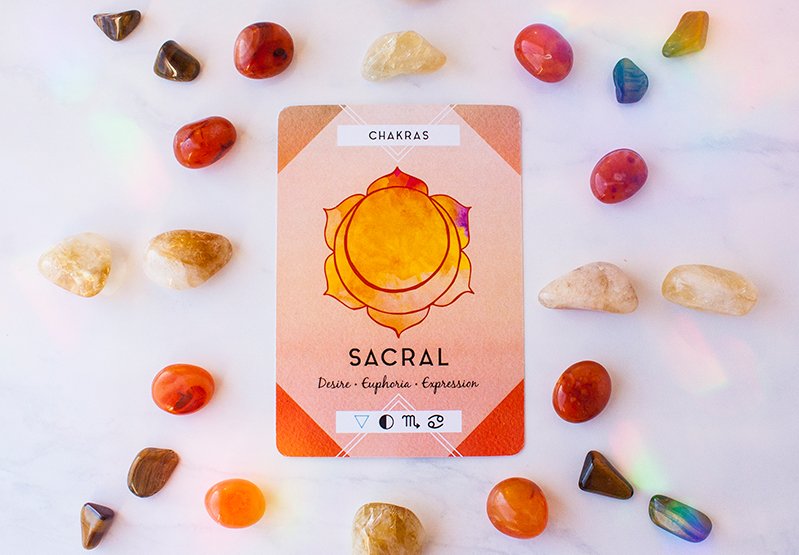
The sacral chakra, Svadhisthana, is one of the chakras I personally feel most connected to. I think in the spiritual community, we can sometimes forget how important the lower chakras are, but remember: you are a spiritual being in a physical body! So the chakras we tend to associate with our physical bodies more, like the root, sacral, and solar plexus chakras, are just as important as the higher chakras like your crown and third eye.
The sacral chakra is your center of creativity, sexuality, and feeling. It’s ruled by the element of water, and it’s located at the center of your low belly about three inches from your navel.
When this chakra is open, you’re able to feel deep pleasure in your life. You’re able to really feel the world around you and you’re connected to your emotions. You’re able to flow, expand, have healthy relationships with others, and use your creativity.
When this chakra is blocked, it may manifest as:
Disconnection from your sexuality or being ruled by your sexuality
Experiencing a lack of pleasure in your day-to-day life
Inability to connect with your creative energy
Feeling stuck in a certain feeling or mood
Dependency on a person or substance that gives you pleasure
Inability to feel your feelings or being too ruled by your emotions
If any of those sound like you, don’t worry. Our chakras are fluid, just like us, and they can change from day to day. Scroll down to get 10 ways to unblock your sacral chakra to connect with your creative and emotional flow.
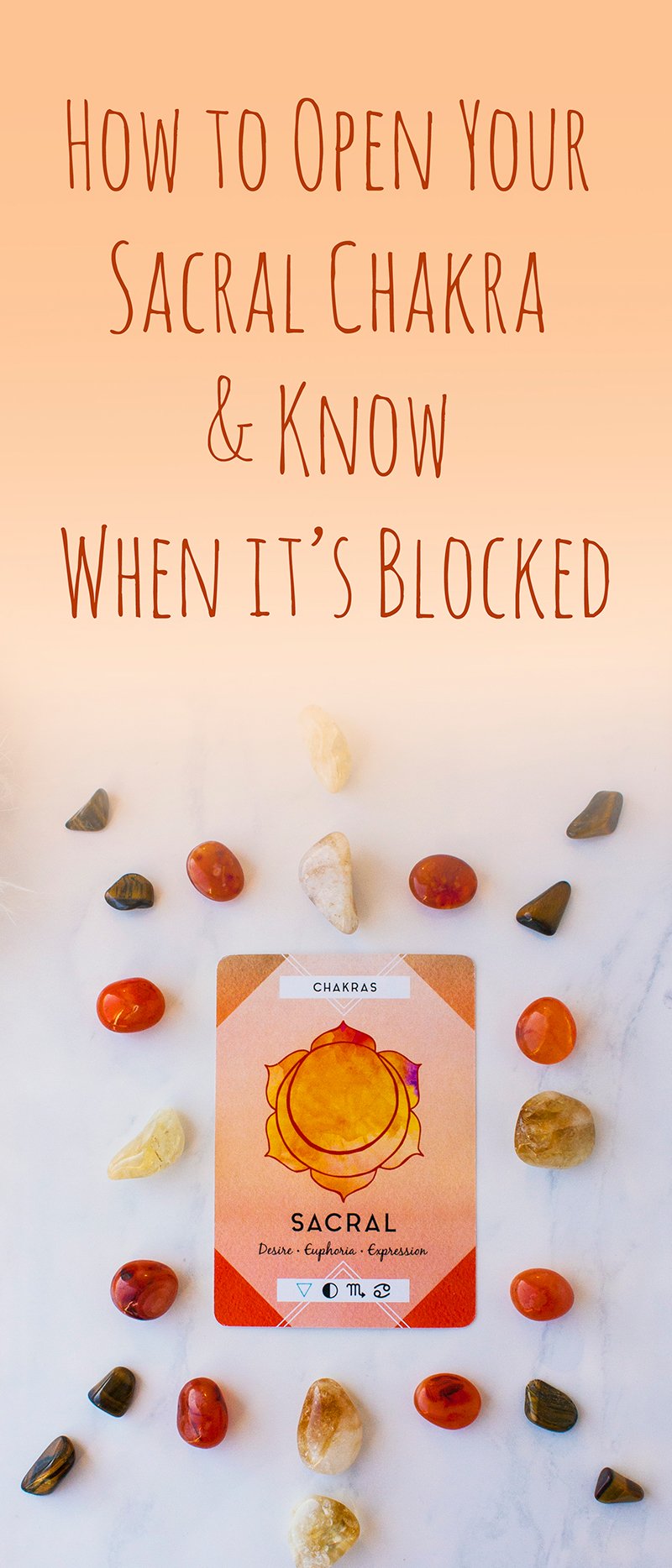
The card shown in the image is from The Ritual Deck.
Get creative
This is one of my favorite ways to open this chakra! Even if you don’t feel creative in the moment, just start creating something. It might surprise you how your energy starts to flow! Try painting, writing, drawing, coloring, collaging, creating your own movement practice, or experimenting in the kitchen.
Use scents
My go-to essential oils for opening your sacral chakra are:
Tangerine
Orange
Ylang ylang
Patchouli
Bergamot
Sandalwood
Rosewood
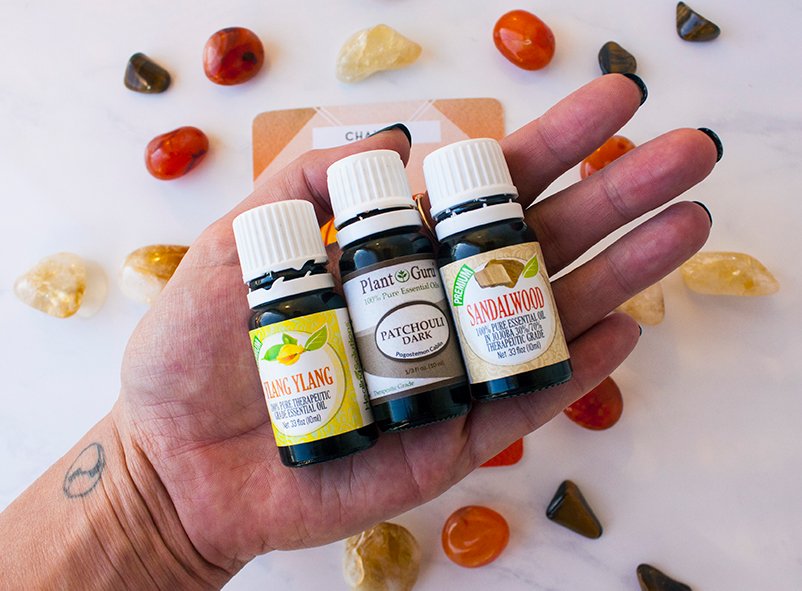
Try massaging your low belly with one or more of the oils (diluting with a carrier oil as needed), diffusing them in your space, or placing a few drops in your bath (which, bonus points, connects you with the element of water!).
Dance
I know everyone says this, but seriously, dance like no one’s watching (because no one is!). Put on your favorite music and move intuitively however feels good for you. If you’d like, incorporate some hip circles to help you get into your low belly.
Breathing into your low belly. As you’re laying down, place your hands on your low belly. With your inhale, feel your hands rise as you flood the belly with breath, sending your life force energy to this chakra. As you exhale, feel your sacral center soften, expand, and open.
Use crystals
Some crystals that help open your sacral chakra are:
Citrine
Carnelian
Orange aventurine
Orange calcite
Goldstone
Tiger’s eye
Sunstone
Peach selenite
Try sleeping with them, meditating with them on your low belly, placing them around your home, or placing a little tumbled stone in your pocket to carry with you all day.
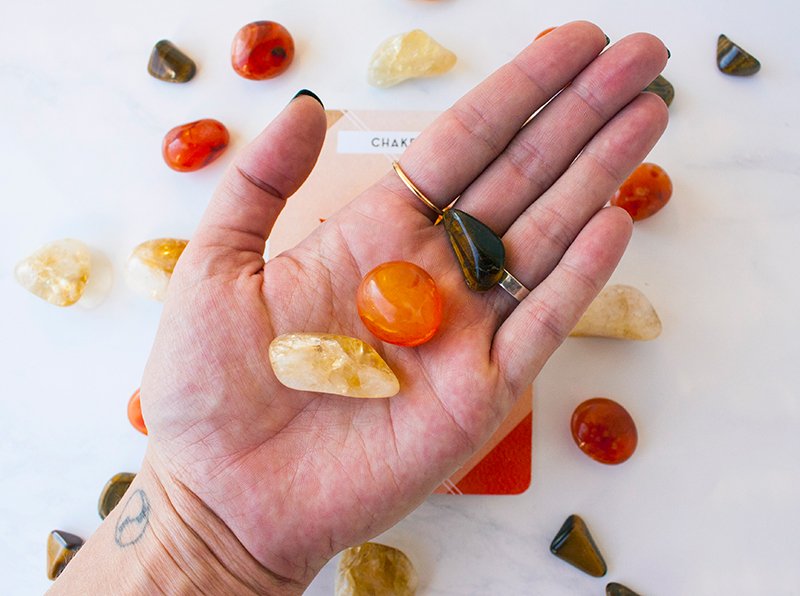
Meditation
Bring your palms to the center of your sacral chakra in your low belly, and start to take deep belly breaths into that space. With each inhale, visualize a little orange ball of light over your sacral chakra. With each exhale, visualize it opening, softening, and expanding until your entire body is surrounded by a beautiful aura of pure orange light.
Check out my Energy Reset Meditation Bundle here.
Use affirmations
Write them down, say them every day, make them the background of your phone—the options are endless! Choose an affirmation from the list below or create your own:
I am fully in my body.
Creative and sexual energy runs through me.
I am in love with life.
I am a passionate being.
I am deeply connected to my feelings.
I honor my feelings.
I honor my pleasure.

Yoga poses
Poses that stretch your hips are really helpful for opening your sacral chakra. Some of my favorites are:
Low lunge
Goddess pose
Reclining cobbler’s pose
Wide-legged standing forward fold
Frog pose
In each pose, just remember to breathe into your low belly!
Get to the root of the blockage
One of my favorite ways to get to the root of a chakra blockage is pulling tarot cards for these two simple questions:
Why is my sacral chakra blocked?
Advice for moving through the blockage
Tarot cards have such a beautiful, helpful way of getting to the heart of the matter. If you’re feeling like there’s a deep, underlying shadow or issue holding you back from fully stepping into your sexual and creative power, try this.
Play with color
The color associated with Svadhisthana is orange. Try bringing more of this color into your life by lighting orange candles, eating orange foods, wearing orange clothes, or painting your nails orange.
How to journal with the moon phases + 10 journal prompts
Your mood, physical body, and spirit body all go through phases, and journaling with the moon is an ideal way to track all of these. You may find that you’re more synced with the moon than you thought!
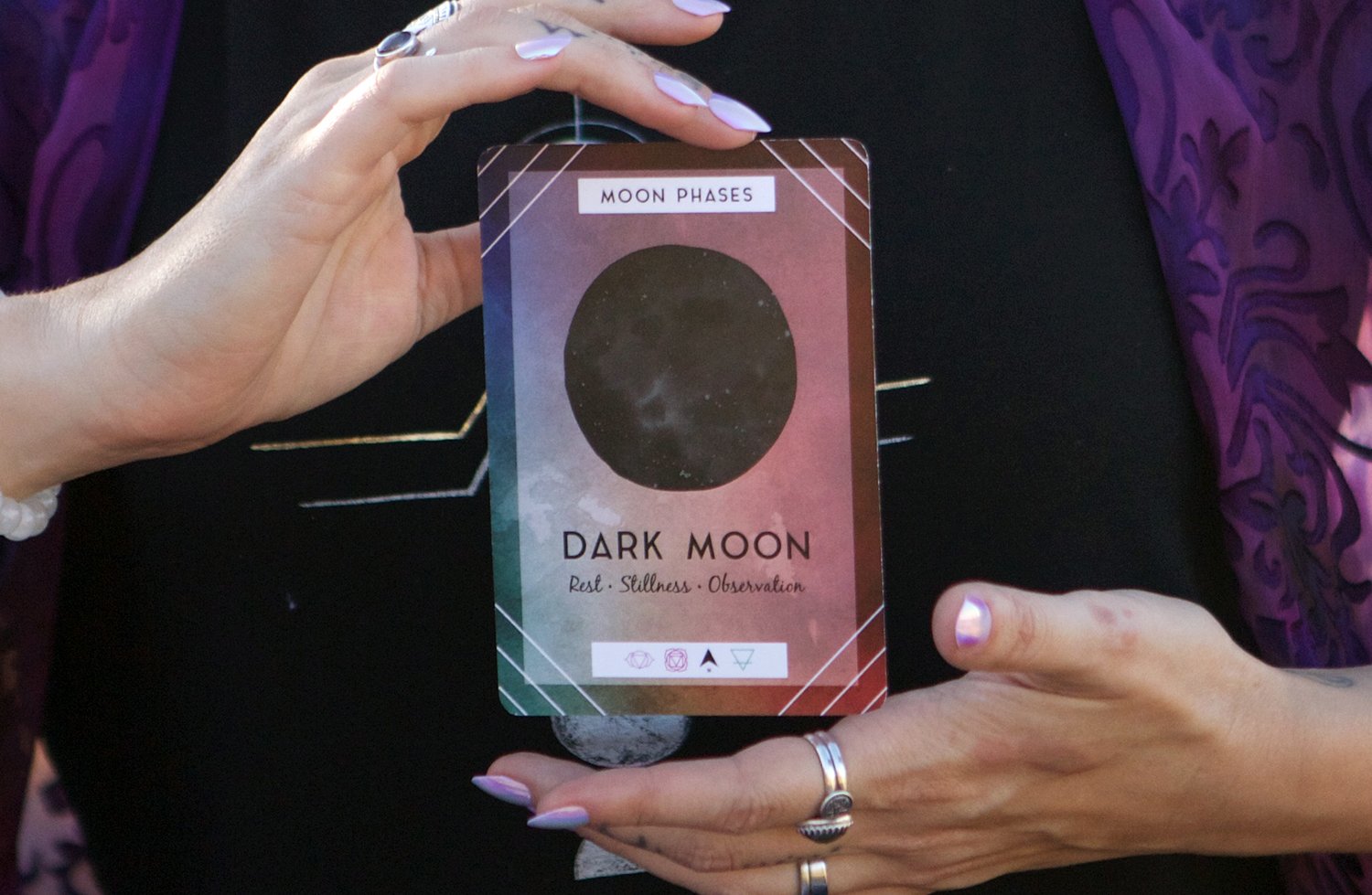
Your mood, physical body, and spirit body all go through phases, and journaling with the moon is an ideal way to track all of these. You may find that you’re more synced with the moon than you thought!
Why You Should Try Moon Journaling
Wouldn’t it be nice to know which moon phases make you feel the most intuitive, expressive, or reserved? The way you relate to each moon phase is reflective of you alone and experiences will vary from person to person. You may find that your diet, intuition, and menstruation are affected by the phases of the moon. Keeping a moon journal will enable you to track any patterns to better understand all of your cycles.
How Often Should You Write in Your Moon Journal?
Take notes in your moon journal as often as you like! Journaling once a week will ensure that you hit each of the main phases of the moon: new moon, waxing moon, full moon, and waning moon. Moon journaling twice a month, on the full and new moon, can also be enlightening.
Starting out, I suggest making a quick note in your moon journal for 30-60 consecutive days. Making a quick note daily, in the beginning, will help you catch any obvious patterns right away.
What You’ll Need to Start Your Moon Journal
You’ll need a moon phase calendar, digital, or a hard copy.
You’ll also need a writing utensil and a journal or notepad. That’s it!

10 Topics for Moon Journaling
Here’s a list of suggested moon journaling topics. Read through the whole list. What topics call out to you the most? You can journal on all or some of these topics, it’s completely up to you.
Start your moon journaling by recording the date, the moon phase, and the zodiac sign for the phase (optional).
Record how you feel emotionally. Check-in, do you feel content, happy, sad, jealous, excited, energized, grateful, anxious, or angry? Record your mood for the day or overall week. This can be as simple as writing one word.
Record how you feel spiritually. How connected and intuitive do you feel? If you meditate regularly, was it easy for you to “drop-in” or did you find your meditation to be a struggle (this is always a good indicator of my spiritual well-being).
Record how you feel physically. How are you sleeping, your energy levels, and your diet? Are there any particular foods you're craving? If you exercise regularly, was your activity easy or more forced?
Record when you start and end your menstrual cycle. You may also decide to notate what each menstrual cycle feels like to help unearth patterns. If you’re particularly in-tune with your cycle or trying to conceive (or not conceive!) you might also find it helpful to track your ovulation with the moon.
Note any goals, intentions, and manifestations you’ve initiated and when they manifest. New intentions are best to set on a new or waxing moon.
Note any habits, people, outcomes, or things you’re trying to let go of and when you feel you’ve shed them. Releasing and letting go is best to initiate during a full or waning moon.
Notate the zodiac sign the moon is in. If you want to take your moon journaling to the next level you can notate what zodiac sign the moon is in. The moon is always positioned in a zodiac sign and cycles through them every 2-3 days. The sign the moon is in will also have an effect on you too. Try looking for even broader patterns by notating what sign the moon is in when you journal. I like this online resource for tracking the zodiac sign for each moon phase.
Track your triumphs! Did something happen that was totally out of the blue and made your day? Maybe you received an unexpected promotion, landed your dream job, or ran into an old friend, write it down!
Track your worst days. Did you have one of those days where nothing seems to go as expected and you just can’t shake it? These days aren’t as fun, but being able to estimate when they may come up can sure be helpful.
Note your dreams. Dream journaling is an insightful activity on its own. Notating the moon phase for your dreams can shed even more light on what your subconscious is trying to tell you. You might be able to identify times when your dreams are most active so you can plan to have a notepad ready on your nightstand.
Moon journaling can be as simple or in-depth as you’d like and can be tailored to suit your needs and schedule.
Ancient Scents & Their Meanings
Have you ever smelled something and it took you back to a specific moment in your life or a certain feeling?We can’t always explain why scents attach themselves to moments in our lives and stick, but we know that scents are powerful.

Have you ever smelled something and it took you back to a specific moment in your life or a certain feeling?
We can’t always explain why scents attach themselves to moments in our lives and stick, but we know that scents are powerful.
Think about how you feel when you smell fresh cut grass, the incense burning in your local yoga studio, onions sautéing on the stove, or winter candles burning.
Each one of those scents probably evokes a specific emotion in you.
This is the power of scents.
Smell is one of the most primal senses, and it can awaken the deep emotions that may be hiding in your cells.
Scents are a way to connect to our heart space. They’re a way to shift our energy, our emotions, and our mood. They can also be an incredible way to connect with the Universe or the Divine.
Some scents, such as the ones below, have their roots in ancient civilizations around the world. They’ve been used for their magickal healing properties in the ancient civilizations of India, Rome, China, Egypt, and more.
Why?
Scroll down to learn more about some of the most powerful ancient scents' meanings and uses.

Frankincense
Frankincense has been used for centuries in the Middle East (where it’s from), Egypt, Israel, Ancient Rome, Ancient Greece, other parts of Europe, and more.

In different cultures, it was used for different things:
As incense in sacred Jewish rituals, Christian ceremonies, and other religious ceremonies in Greece, Rome, Egypt, and Israel
Healing and purification in the Ayurvedic tradition
To drive insects away in the Middle East
Flavoring food and drinks in the Middle East
In burial rituals in Egypt and Rome
To treat medical issues including ulcers, nausea, post-childbirth recovery, chest coughs, and fever
To embalm bodies in Ancient Egypt
Besides its practical uses, it was revered as a powerful tool for protection, purification, and connecting with the divine.
How can you incorporate frankincense into your life today? Here are some ideas:
Burn frankincense resin as an offering to a goddess you’re working with
Use frankincense oil to anoint your candles in candle magick
Use frankincense oil (diluting with a carrier oil if needed!) on your wrists before meditation or ritual work
Rub the soles of your feet with frankincense oil before bed to help you relax
Diffuse frankincense oil on summer nights on your porch for a natural bug spray
Use frankincense oil as a perfume on your skin to imbue your day to day with some extra magic
Burn frankincense incense in your space to protect and purify it
Myrrh
Myrrh also comes from trees in the Middle East and North Africa, and was used alongside frankincense in the great ancient civilizations of Egypt, Israel, Europe, and the Middle East. Where frankincense is associated with the sun, myrrh is a bit murkier. It’s associated with the sun because its tree thrives in the desert sun, but it’s also associated with the moon, because of its strong feminine history as an herb for ancient goddesses.
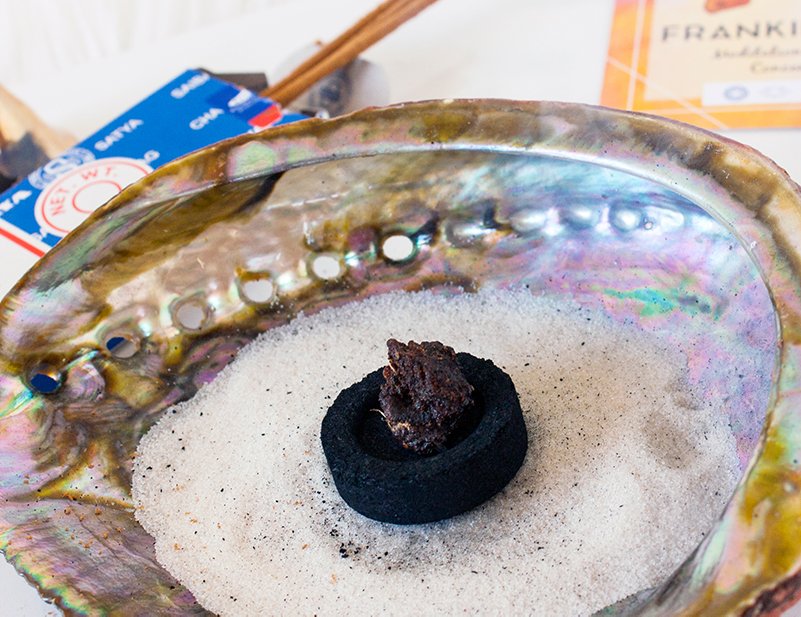
Some of its historical uses are:
Embalming the dead in ancient Egypt
Used as medicine, especially with honey, in ancient Egypt for many illnesses, especially skin conditions, infections, and bruises
Burning as sacred incense in Christian traditions
Used in ancient Egyptian rites as an offering to the sun god Ra and goddess Isis
As a perfume and purification oil for the Hebrew people
For its restorative properties in Eastern medicine
Myrrh was used as a powerful tool for healing, protection, purification, meditation, and expanding inner wisdom. It was often used as a great complement to frankincense, and it’s thought that combining the two even increases their power.Try these ideas for incorporating myrrh into your life today:
Burn myrrh resin on your altar as an offering to the goddess Isis
Use in banishing and protection rituals and spells
Purify and bless magical tools such as your tarot cards, crystals, and talismans
Burn myrrh incense when you need personal healing and comfort
Use myrrh oil on your skin (diluting with carrier oil if necessary) to help you meditate
Incorporate into any of your work with frankincense above
Sandalwood

Sandalwood isn’t technically an herb. It’s actually, like the name suggests, a type of wood. Sandalwood has been used for thousands of years in many different contexts, including:
Buddhist rituals
Muslim rituals
Egyptian embalming rituals
Folk medicine in Tibet and China
In carvings for shrines and homes in India
In figurines and jewelry in India
As a paste for anointing in Hindu temples
As a perfume and soap in Europe
As a powerful remedy in the Ayurvedic system of medicine
Consecrating ritual tools in Hindu ceremonies
Practically, sandalwood has been used for its anti-inflammatory and cleansing properties. Magically and energetically, sandalwood has been used for many things including healing, purification, grounding while also assisting in meditation, clearing negativity, deep spiritual relaxation, clairvoyance, and manifestation.Some ways to use sandalwood in your life are:
Write your desires on a stick of sandalwood on the new moon and burn it, letting the smoke carry your desires into the universe
Cleanse your magical tools (like crystals, athames, cauldrons, and tarot cards) of negative energy
Burn sandalwood chips to help heal coughs and UTIs
Burn sandalwood incense for meditation
Burn sandalwood incense or chips for astral projection and communicating with spirits
Wear sandalwood beads for higher spiritual awareness
Nag Champa
If you’ve ever walked into a yoga studio or a witchy shop, you’ve probably smelled the earthy, slightly sweet scent of Nag Champa. But what is Nag Champa?
It’s a blend of different scents, most famously the champa flower, as well as sandalwood, and halmaddi resin. The champa flower from the Magnolia champaca tree, a tree often planted near ashrams, has long been prized in India for its sweet fragrance and bright yellow color.
As you’ve probably guessed, Nag Champa’s origins are as incense in India where it was often used for meditation, yoga, and rituals in Hindu temples and ashrams. It’s now one of the most popular incense scents in the world!
Nag Champa is thought to stimulate spiritual awareness while simultaneously grounding you in the present.

Here are some ideas for incorporating this popular scent into your life:
Burn Nag Champa when you meditate or do yoga
Use Nag Champa oil as a perfume
Burn Nag Champa for chanting and kirtan practices
Use Nag Champa oil to massage your feet (diluting if needed!)
Use Nag Champ soap or body wash (there are tons of options) to add some magic to your everyday
The Spiritual Side of Boundary Setting + 4 Steps to Help You Set Boundaries
Many of us, especially women, have been taught to give and give and give without question. Over time, as you probably know, this becomes exhausting and depleting. You might already have strong boundaries, or maybe you’re realizing just now that you really need to set them, but you’re afraid. If you’ve been waiting for a permission slip to create more boundaries in your life, consider this it.You are a powerful being, and you get to decide what is and is not acceptable to you in your life…
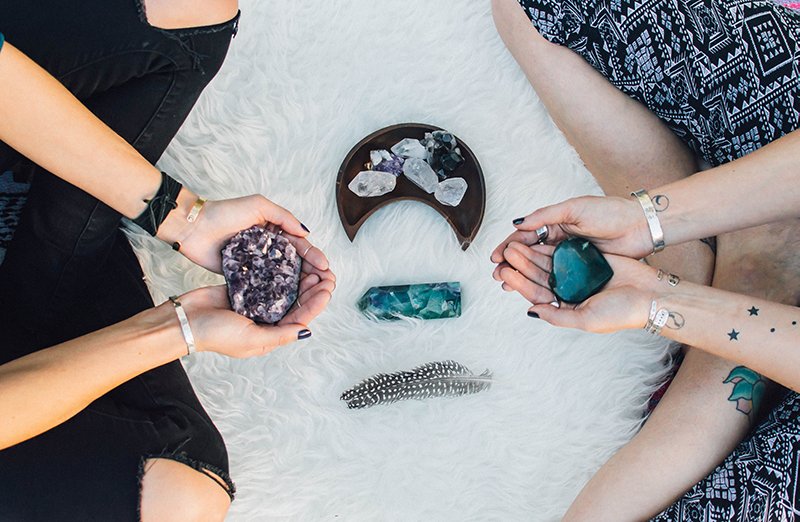
Many of us, especially women, have been taught to give and give and give without question. Over time, as you probably know, this becomes exhausting and depleting. You might already have strong boundaries, or maybe you’re realizing just now that you really need to set them, but you’re afraid. If you’ve been waiting for a permission slip to create more boundaries in your life, consider this it.
You are a powerful being, and you get to decide what is and is not acceptable to you in your life (if reading that gave you a strong reaction, check out this post for tips to connect with your authentic power). You are allowed to take up space. You are allowed to speak up and stand up for yourself. This is the spiritual work of boundary setting.

Boundaries are an important way of setting the terms for how it is and isn’t okay for other people to interact with you, and on an energetic level, they’re a way of protecting your own energy.
Because spiritual work isn’t all pretty all the time. Sometimes it’s the deep, unglamorous work of digging into the roots of your heart and seeing what you truly need, and then telling people that no, you won’t answer their DMs, or no, you won’t do free work anymore, or no, you can’t hold energetic support for them at this moment because you simply have nothing left to give.
I saw Gabby Bernstein live last year, and during the Q&A portion of the night a woman went up to the mic and told Gabby that she was feeling so spiritual these days— so spiritual, in fact, that all she wanted to do was lock herself in her room and meditate and read spiritual books. She said she was starting to resent her life— her kids, her work, her husband— for taking her out of that.
Gabby said, “Here’s what you don’t yet understand: your life is your spiritual practice.”

That’s always stood out to me. Meditating, ritual, yoga, tarot, all of the things we love— they can all be part of your spiritual practice. But they’re not THE spiritual practice. Your spiritual practice is how you treat people, how you treat yourself, how you move in the world, how you set boundaries.
And since we’re always evolving and growing, our boundaries are always evolving, too.
Scroll down for some tips on how to set clear boundaries.
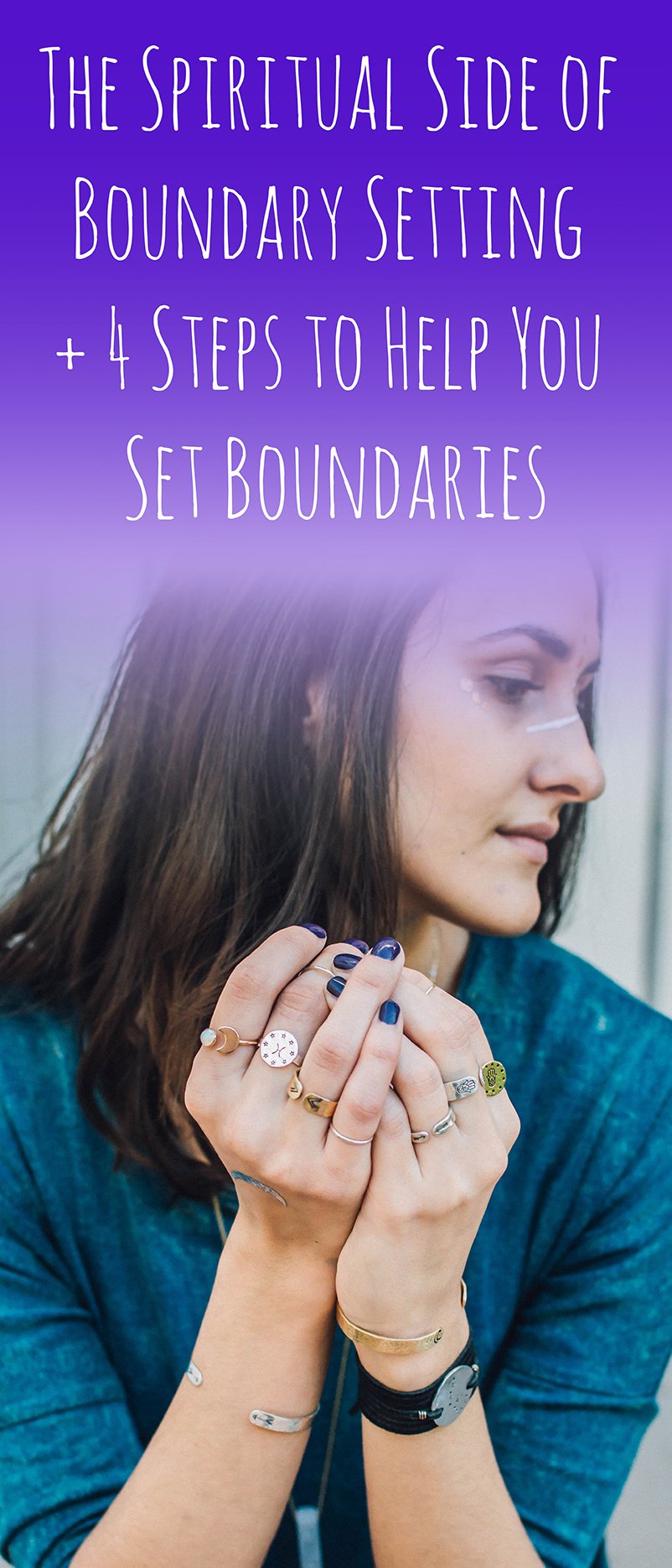
Figure out what your boundaries are
How do you know which boundaries need to be set? How do you know when a boundary has been violated?
Practice checking in with your feelings. Boundary violations may manifest as making you feel powerless, confused, drained, disassociated, angry, or upset. When you feel that way, take an honest look and ask yourself why?
Did someone treat you in a way that’s unacceptable to you? Did you perform free emotional labor that’s leaving you drained? Are you speaking to yourself in a way that’s hurtful?
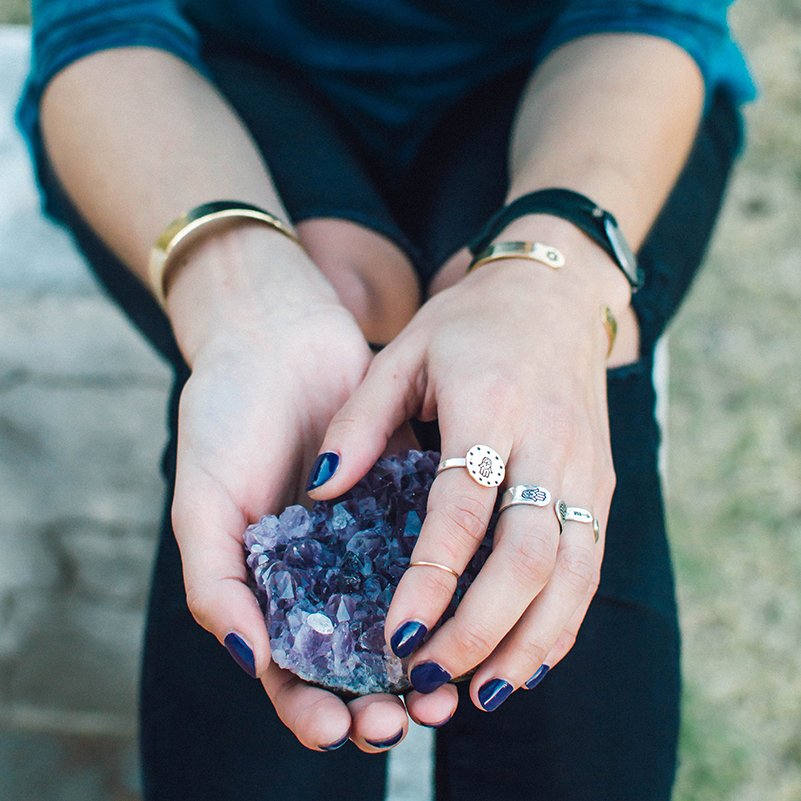
Dig in and look at why you may struggle to set boundaries
Try these journaling questions:
What did I learn as a child about the importance of being liked, going with the flow, and saying yes?
What did I learn as a child about saying and hearing “no?”
What am I afraid will happen if I set and stick with clear boundaries?
Open your throat chakra
The state of your throat chakra is heavily associated with your ability to set and communicate clear boundaries. When your throat chakra is blocked, you might be afraid to stand up for yourself and be seen or fear being judged for the boundaries you set. Get seven ways to balance your throat chakra here.
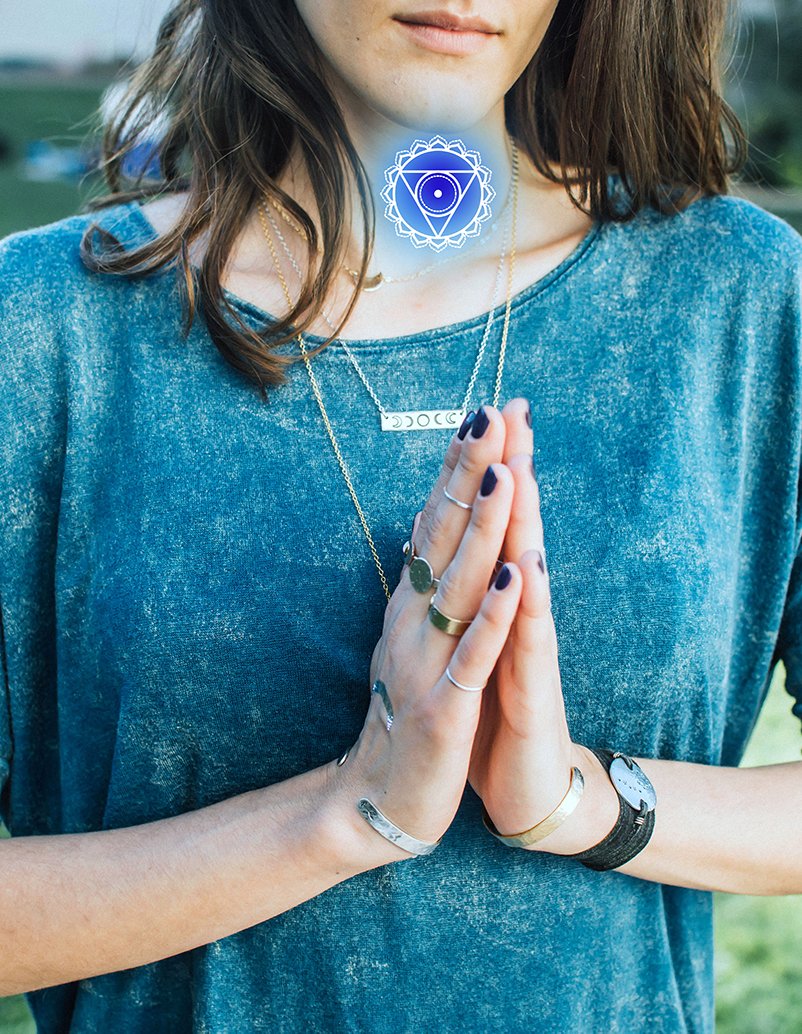
Communicate clearly
Once you’ve done the work in steps 1-3, this step should come more easily. Just remember when you’re communicating your boundaries to stand firm. You can speak your boundaries with love and compassion without apologizing, feeling guilty, or making them feel optional. Be as clear, honest, and direct as you can.
Remember, you have to set that boundary clearly with yourself before you can communicate it to anyone else.

You’ve heard it before but I’ll say it again: saying no creates the space for your big YES to come in—whether that’s relationships with people who treat you well, a job that fulfills your soul, or something else. Setting boundaries aren’t just about saying no, it’s about saying YES to only the things that feel good to you and light your soul up.
What’s your relationship with boundary setting? Now’s a perfect time to take a look!
